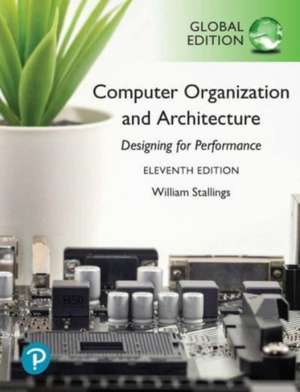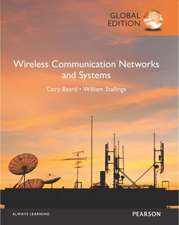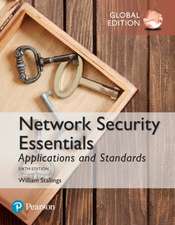Computer Organization and Architecture, Global Edition
Autor William Stallingsen Limba Engleză Paperback – 23 noi 2021
Preț: 522.71 lei
Preț vechi: 600.82 lei
-13% Nou
Puncte Express: 784
Preț estimativ în valută:
100.02€ • 106.96$ • 83.40£
100.02€ • 106.96$ • 83.40£
Carte disponibilă
Livrare economică 27 martie-10 aprilie
Livrare express 13-19 martie pentru 58.11 lei
Preluare comenzi: 021 569.72.76
Specificații
ISBN-13: 9781292420103
ISBN-10: 1292420103
Pagini: 896
Dimensiuni: 179 x 231 x 32 mm
Greutate: 1.3 kg
Ediția:11 ed
Editura: Pearson Education
ISBN-10: 1292420103
Pagini: 896
Dimensiuni: 179 x 231 x 32 mm
Greutate: 1.3 kg
Ediția:11 ed
Editura: Pearson Education
Notă biografică
Dr. William Stallings has authored 18 textbooks and over 70 books on computer security, computer networking, and computer architecture. With over 30 years experience in the field, he has worked as a technical contributor, technical manager, and an executive at several high-technology firms. Currently, he is an independent consultant whose clients have included computer and networking manufacturers and customers, software development firms, and leading-edge government research institutions. He has received the award for the best computer science textbook of the year thirteen times from the Text and Academic Authors Association. Dr. Stallings created and maintains the Computer Science Student Resource Site at ComputerScienceStudent.com. This site provides documents and links on a variety of subjects of general interest to computer science students and professionals. He is a member of the editorial board of Cryptologia, a scholarly journal devoted to all aspects of cryptology. He holds a Ph.D. from MIT in computer science and a B.S. from Notre Dame in electrical engineering.
Cuprins
I. Introduction 1. Basic Concepts and Computer Evolution 2. Performance Concepts II. The Computer System 3. A Top-Level View of Computer Function and Interconnection 4. The Memory Hierarchy: Locality and Performance 5. Cache Memory 6. Internal Memory 7. External Memory 8. Input/Output 9. Operating System Support III. Arithmetic and Logic 10. Number Systems 11. Computer Arithmetic 12. Digital Logic IV. Instruction Sets and Assembly Language 13. Instruction Sets: Characteristics and Functions 14. Instruction Sets: Addressing Modes and Formats 15. Assembly Language and Related Topics V. The Central Processing Unit 16. Processor Structure and Function 17. Reduced Instruction Set Computers 18. Instruction-Level Parallelism and Superscalar Processors 19. Control Unit Operation and Microprogrammed Control VI. Parallel Organization 20. Parallel Processing 21. Multicore Computers






